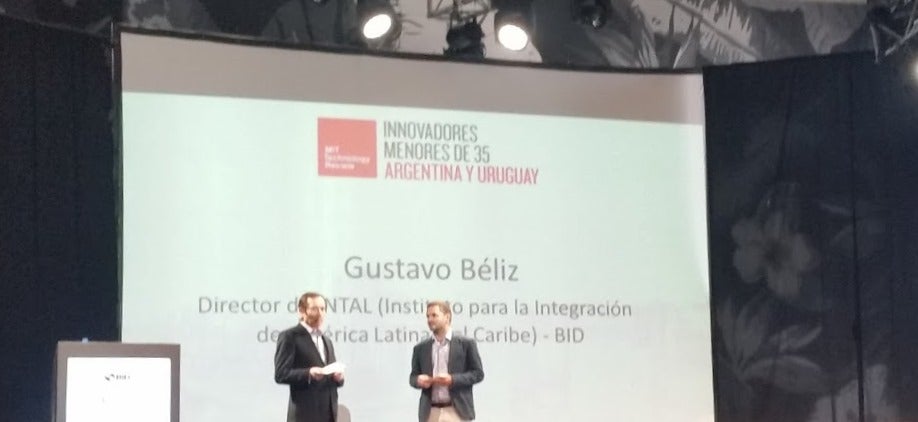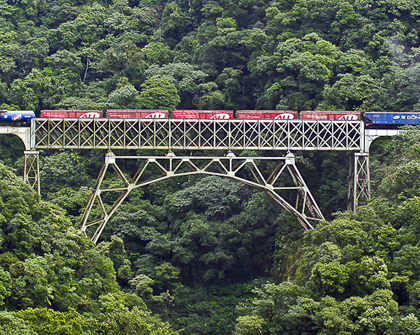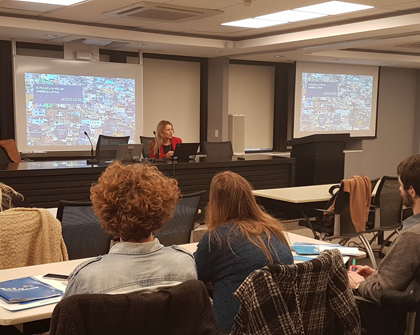This year’s award ceremony for the Top Ten Innovators Under 35 competition in Argentina and Uruguay took place on Friday, September 23, 2016, at the Tecnópolis precinct in Buenos Aires. The winners were selected by the MIT Technology Review en español for their inspiring projects with the potential for social impact. The event was organized in partnership with various institutions, including INTAL, Argentina’s Ministry of Science, Technology, and Productive Innovation, and the National Institute of Industrial Technology (INTI).

The competition has been run for over a decade throughout the world and which numbers Mark Zuckerberg of Facebook and Sergey Brin of Google among its winners. This year, the prize went to Alejandro Esperanza, the creator Gurucargo, an online platform that enables importers and exporters to obtain quotes for shipping sea, land, and air freight quickly and easily. This reduces costs, democratizes access to international logistics, and benefits SMEs by cutting out middlemen.
The event also included presentations from the winners of INTALENT, the competition that INTAL ran in the first half of 2016 in partnership with the MIT Technology Review en español and Argentina’s Ministry of Culture.
INTALENT is a competition around innovation in the creative industries with an impact on integration and trade. It recognizes technologically based innovative talent within the Orange Economy in Latin America and the Caribbean. The competition seeks out initiatives whose intellectual property-based achievements have the potential to generate wealth and contribute to improving the lives of those living in Latin America and the Caribbean.
Over 680 projects from 20 countries in Latin America and the Caribbean took part in the competition. These were evaluated by juries with different areas of expertise from throughout the region. The judges assessed innovation, the candidate’s experience as an entrepreneur within his or her creative industry, the development and impact that the project is having on the region, its potential to stand out within the creative industry, and its contribution to increasing trade and regional integration, among other factors.
As he was introducing the winners, INTAL director Gustavo Beliz said, “The creative sector drives income generation, creates jobs, and boosts exports while also fostering social inclusion, cultural diversity, and human development.” He went on to talk about the impact of the creative sector: “It is the sector that has grown the most in Latin America and the Caribbean in recent years, creating 10 million jobs and exports worth US$18 billion.”
The first prize for the INTALENT competition, US$10,000 and a trip to Emtech, the emerging technology event organized by the MIT Technology Review in Boston, went to Stereotheque, a platform for exploring music on the basis of your location, preferences, and a touch of serendipity, and which functions on the basis of artificial intelligence.
The second prize, a trip to Demand Solutions, the IDB’s start-up event in Washington, went to Linguoo, an audio app for news articles. The app’s community functions like an intelligent, customized, and inclusive radio station where volunteers read articles from different newspapers, magazines, and blogs in different languages.

Discussions on the Future: Artificial Intelligence, Robotics, Smart Materials, and Nanotechnology
The conference included roundtable discussions where experts presented the latest advances in breakthrough technologies in different areas. Robert Nicol, director of the technology labs at the Broad Institute of MIT and Harvard, presented the human genome project that will enable “DNA sequences to be read and reprogrammed” in the near future.
Galo Soler Illia, dean of the Nanosystems Institute at the National University of San Martín, showed how nanomaterials are being used in everyday objects such as tennis rackets, cars, and television sets. Joanna Berzowska, head of electronic textiles at OMsignal, made waves with her descriptions of clothing that generates energy from the wearer’s movements.
Stella Loiacono, CTO of IBM Argentina, outlined the cognitive computation projects that the company is working on. Developments in artificial intelligence mean that robots can interact with users, come up with reasoned answers to certain questions, and improve their response times. According to Loiacano, these advances “are not seeking to replace humans as decision makers but to help them go about their day-to-day activities.”
Finally, Diego Fernández Slezak, professor of computing at the University of Buenos Aires’s School of Exact and Natural Sciences, spoke of how his department is working on a tool that gathers information on how people use the internet and that can predict certain psychiatric illnesses such as Parkinson’s, bipolar disorder, or formal thought disorder on the basis of the words they use to communicate.

The Winning Projects of the 2016 Ten Innovators Under 35 Competition in Argentina and Uruguay
- Marcelo Wilkorswsky received an honorable mention as a social innovator thanks to his Oincs (link in Spanish) platform, which uses collective intelligence to create a network of real-time traffic and crime alerts.
- Danilo Cantero is one of the creators of Fast Sugars, which is seeking to replace petroleum in the production of plastics and synthetics. To achieve this, he has designed a reactor to extract sugars from the cellulose in agricultural waste in milliseconds.
- Francisco Colombatti, director of development at the Biotech-Lab at Molinos Río de la Plata, has developed a microbiological treatment that inhibits the growth of the bacteria and fungus that produce salmonella in soy flour. The treatment reduces the cost of this product by making it safer and more reliable.
- Fernando Derossi is one of the founders of Agrozone, a company that uses big data and image processing to increase agricultural productivity levels. The app provides producers with information that keeps them ahead of factors that could have a negative impact on their crops, such as pests or diseases, for example.
- Solange Massa, an Argentine doctor who is currently carrying out research at Harvard and MIT, has invented a chip that replicates human liver function to test the toxicity of new pharmaceuticals. This would replace testing on animals and in vitro cell cultures.
- Diego Sáenz is one of the creators of Bluesmart, a smart online suitcase that improves your travel experience. The suitcase can be tracked by GPS at any time. It also has a digital lock that closes automatically when the owner moves away and a weight sensor that lets you know if your baggage is within airline weight limits. The company have sold over 25,000 units to date.
- Lucas Toledo is one of the inventors of GiFlybike, a bicycle that folds up in a second with a single movement. Unlike other folding bikes, GiFlybike has large (26″) wheels with solid, puncture-proof tires that don’t need to be pumped up. And if riders get tired of peddling, the bike comes with an electric assist with a range of up to 60 km.
- Lucía Spangenberg is one of the founders of Genlives, the company which provides genome studies that decode DNA into valuable information for diagnosing, treating, preventing, and evaluating complications in a range of illnesses. These studies include massive genome sequencing (whole genome, exome, specific gene panels).
- Guido Vilariño is one of the creators of Democracia OS, a web app that enables political parties, NGOs, and government offices to open a direct line of communication with citizens. The aim of the platform is to modernize politics and bring it into the digital era by improving the links between political representatives and those they represent.




